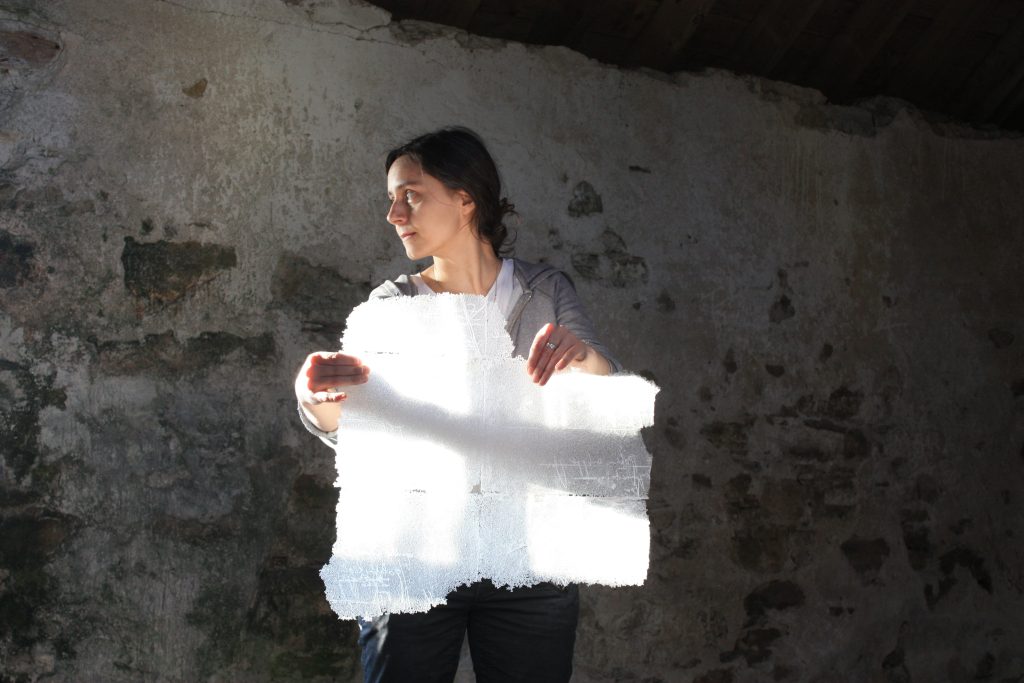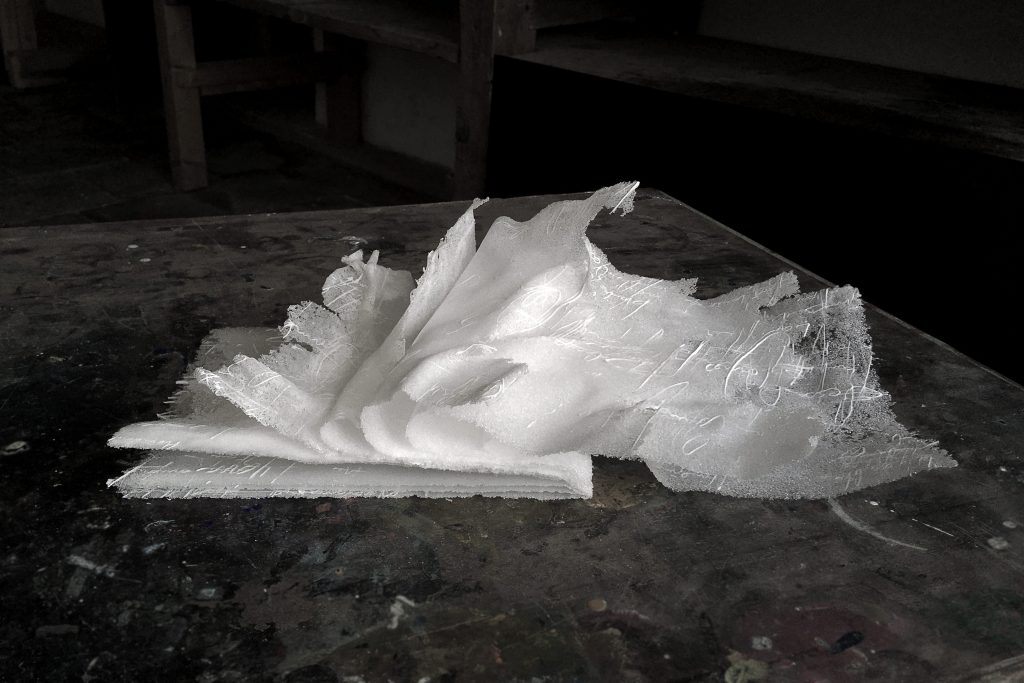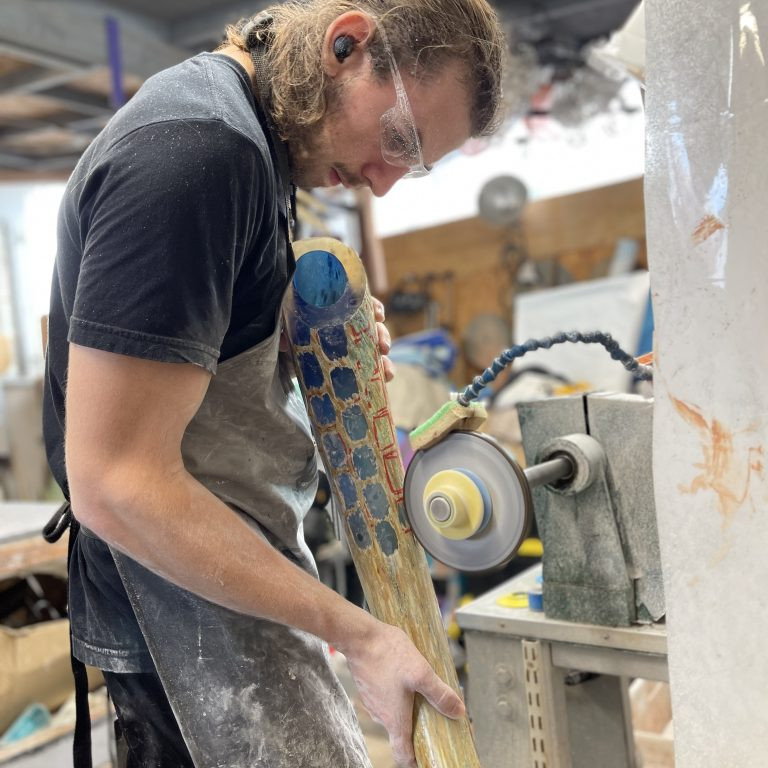Anne Petters Glass Artist
Having been born in Dresden how has this affected your art, with movements from, Germany, to USA and finally England?
Born in Dresden in 1978 I grew up in the German Democratic Republic, a country that doesn’t exist anymore. I always understood the political change in my country, which I experienced as a displacement of reality, as a basic influence on my lifestyle and artistic work. My interest in controlling and displaying moments of our fleeting, vulnerable existence leads leads me to a poetic, metaphoric use of glass and other materials, including natural phenomena.
I see my work as an empathetic comment on our transience and the desire to control time and fleetingness.
I am very drawn to experiencing other realities and inspiring my art practice by traveling and getting to know other perspectives. Art can be a tool for breaking with familiarities and for sparking curiosity to work against indifference.
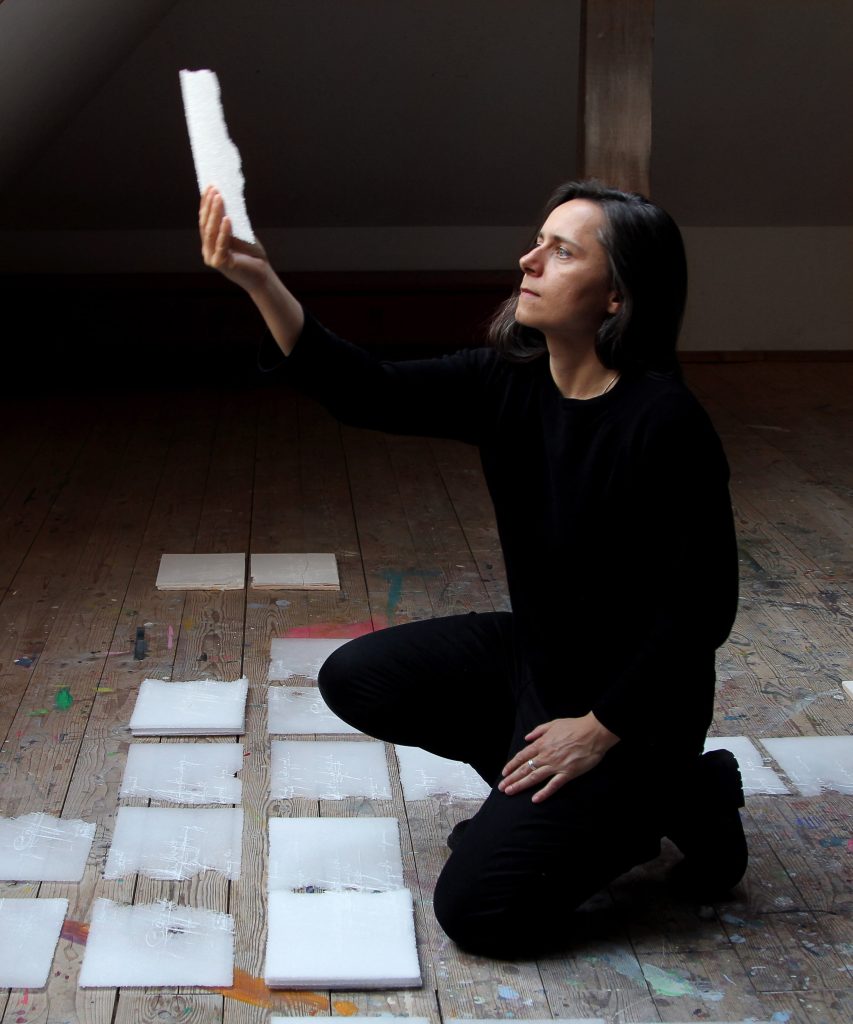
Photograph by Torsten Rötzsch
How are you now passing on your knowledge to other artists?
I am teaching a lot at Universities internationally but also in specialised glass studios like the Corning Museum of Glass, Pilchuck Glass, Penland School of Craft, Summer Academy Bild-Werk Frauenau, Urban Glass to name a few. I enjoy sharing my art and inspiration not only through extensive exhibitions but lectures and workshops world wide. It is never only passing on, it is exchange, I do get back a lot.
You now lecture at City and Guilds in London. How does teaching influence your own artwork?
I find it very important to be part of an academic discourse. It means a constant flow of ideas and being close to a contemporary Zeitgeist, to art in a philosophical, historical, social and political context. Academies bring together artists from all age groups and ethnic and social backgrounds.
Of course teaching also comes with a lot of distraction and interruption to one’s own creative flow. It is often difficult to find the balance. But I would not want to miss it completely. It is another level of sharing ideas in addition to art making and exhibiting.
Tell us about your installation at Coventry Cathedral in place of the vandalized window.
How was the original damaged done?
In January 2020, the Angel of the Eternal gospel, one of John Hutton’s engraved over life size angel and saint figures that decorate the cathedral’s west screen was smashed during a break in. Someone tried to steal the donation box and in an act of complete ignorance broke this panel of the iconic piece of art work.
The people who did it were never found.
How did the commission come about?
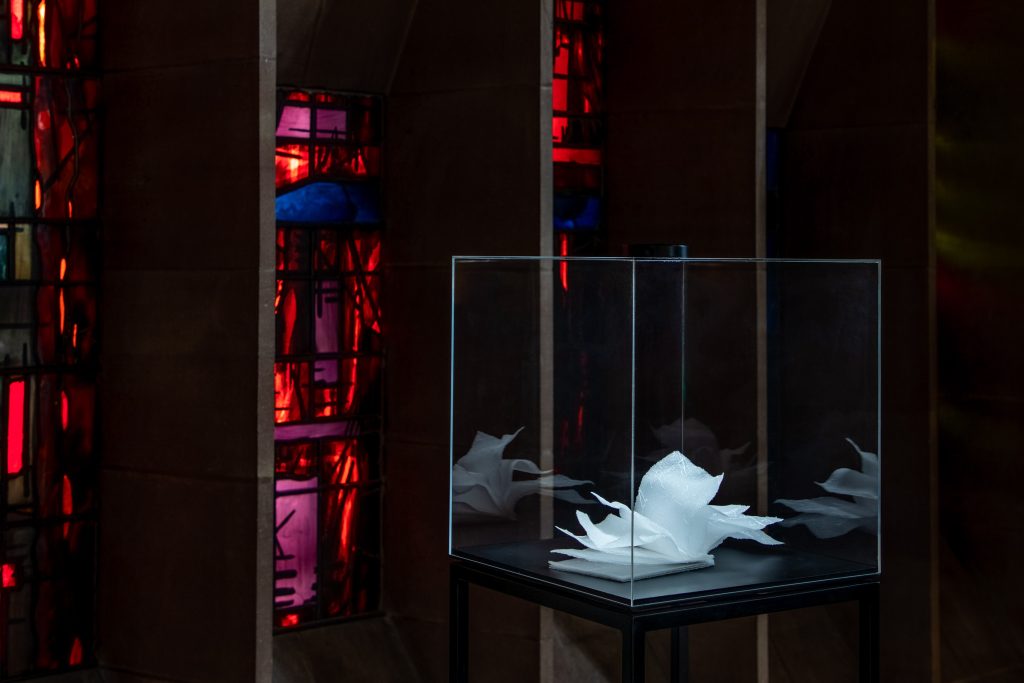 Photograph credit Martina O’Shea
Photograph credit Martina O’Shea
The ‘New’ Cathedral, designed by architect Basil Spence, was build after the old one has been bombed and destroyed in 1941 during a blitz bombing by the Germans.
The statement of building a complete new cathedral in the 50‘s and 60‘s in a modern architecture, a Phoenix-like idea, still reflects in the cathedral’s ethos today.
The Very Rev’d John Witcombe, Dean of Coventry, decided to not replace the panel as it was, since the artist John Hutton died in 1978 and his own way of glass carving was very unique and revolutionary. Instead he approached acclaimed curator and professor Mike Tooby to find a contemporary response to this new act of violence and destruction. Mike Tooby invited me to create a piece of art work as the first artist, followed by Barbara Walker and Abigail Reynolds. The invitation came as response to the series ‘Books of Disquiet’ a series of glass books that I have been making since 2017.
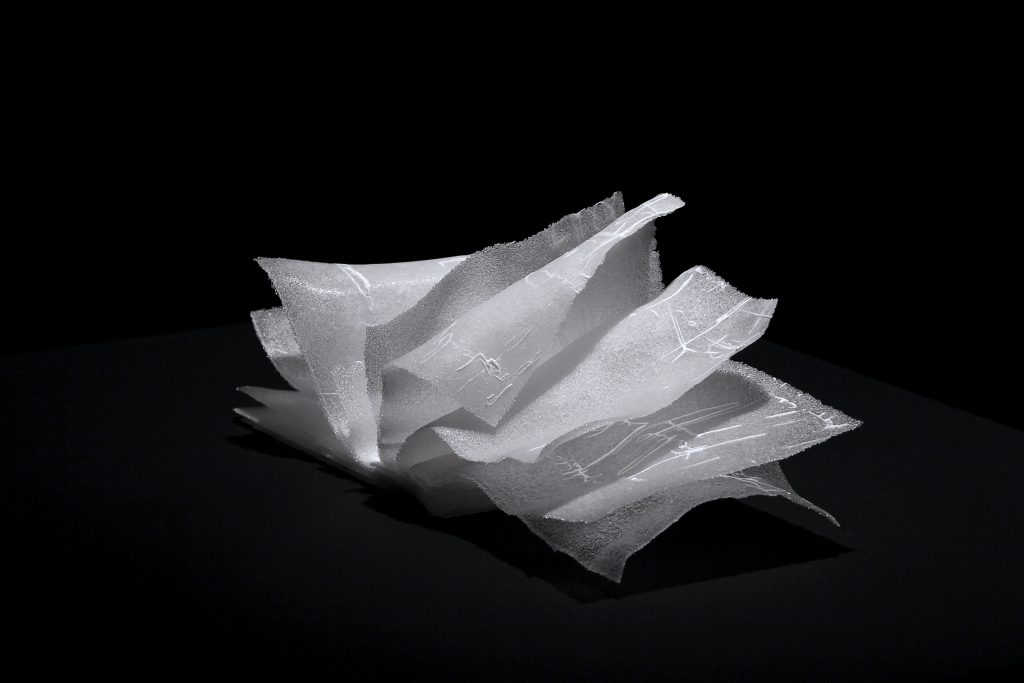 Books of Disquiet IX Photograph Credit, Anne Petters
Books of Disquiet IX Photograph Credit, Anne Petters
They caught Mike Tooby’s attention in the context of the destroyed Angel holding the gospel.
I had complete freedom for this project and decided to work with light and projection, a more ephemeral approach. In Lichtung – Break, the title of the installation, I am projecting a broken piece of glass back onto the screen where the Angel was.
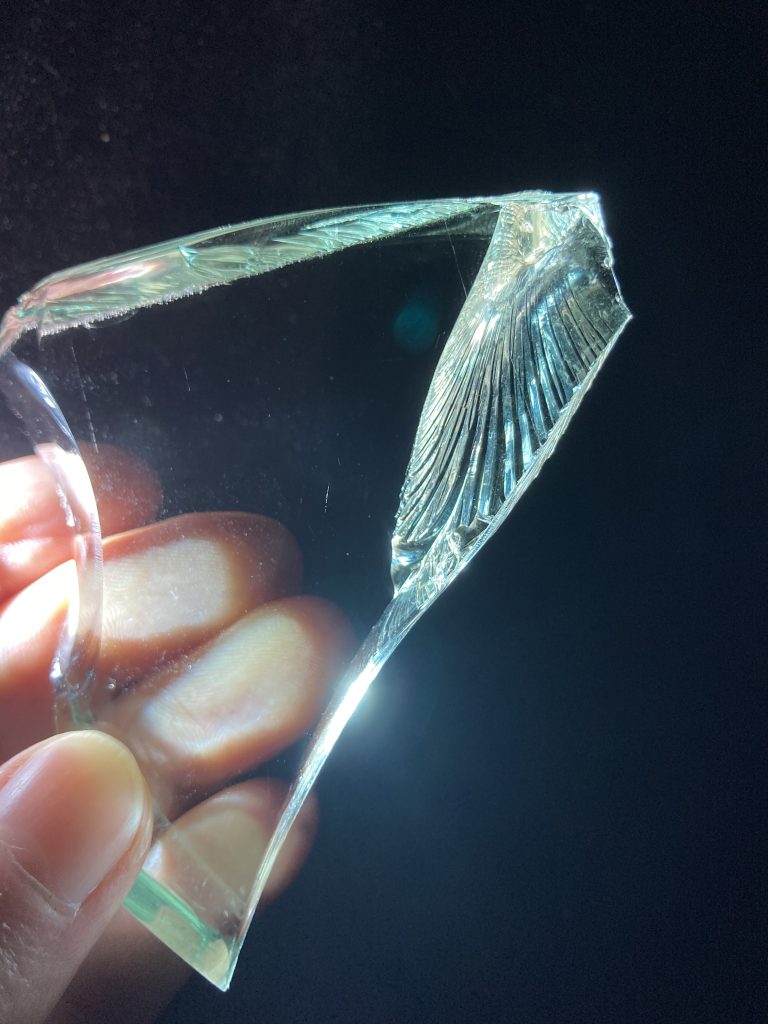 Photograph, Anne Petters Lichtung-Break
Photograph, Anne Petters Lichtung-Break
The break of the glass, a conchoidal shell like fracture, perfectly responded to John Hutton’s gesture of engraving, the feathering suggests an angel’s wing taking flight, or landing. The image would appear and disappear at dawn and dusk, an ephemeral comment on the recurring theme of suffering, death, hope and light.
 Lichtung-Break, Photograph, Anne Petters
Lichtung-Break, Photograph, Anne Petters
What was the briefing for the commission?
There was no briefing, the artists were invited.
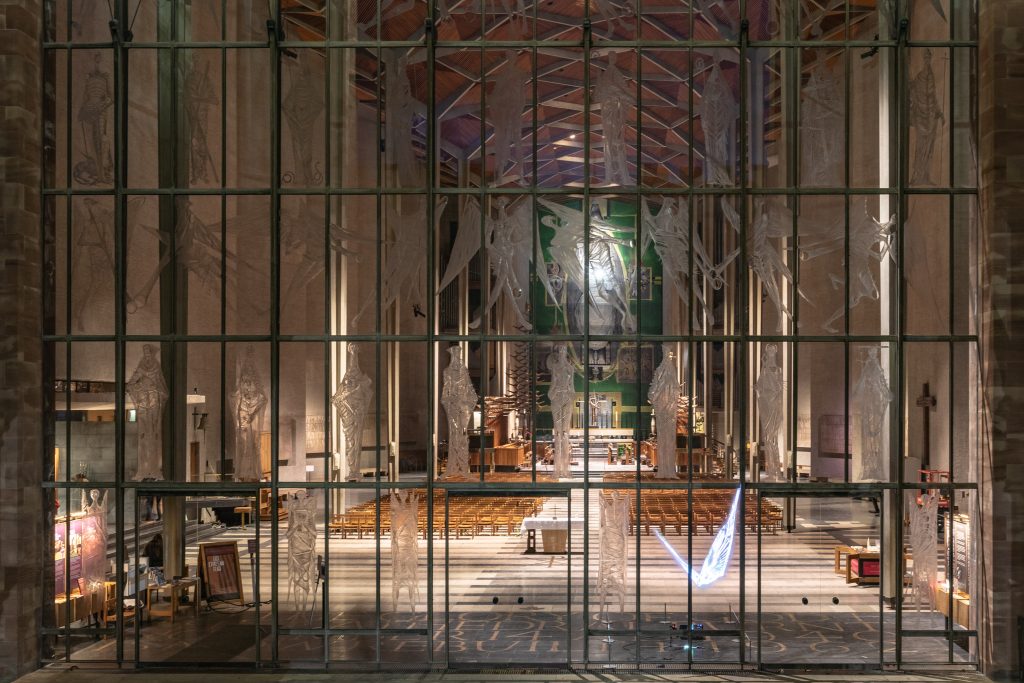 Lichtung-Break Coventry Cathedral Photograph credit Martina O’Shea
Lichtung-Break Coventry Cathedral Photograph credit Martina O’Shea
What has been the reaction to the commission by the public?
The Installation Lichtung – Break received a very touching response from many members of the community of Coventry. It was the first public art work I made and it was very rewarding to be able to move so many people. Usually I work for galleries and art institutions that naturally come with an audience with an artist background. Making work for a public community and trying to find something that is accessible yet sublime and that can be understood and experienced by people of all ages and backgrounds was a haunting challenge at first, but it naturally came to be and fell in place beautifully.
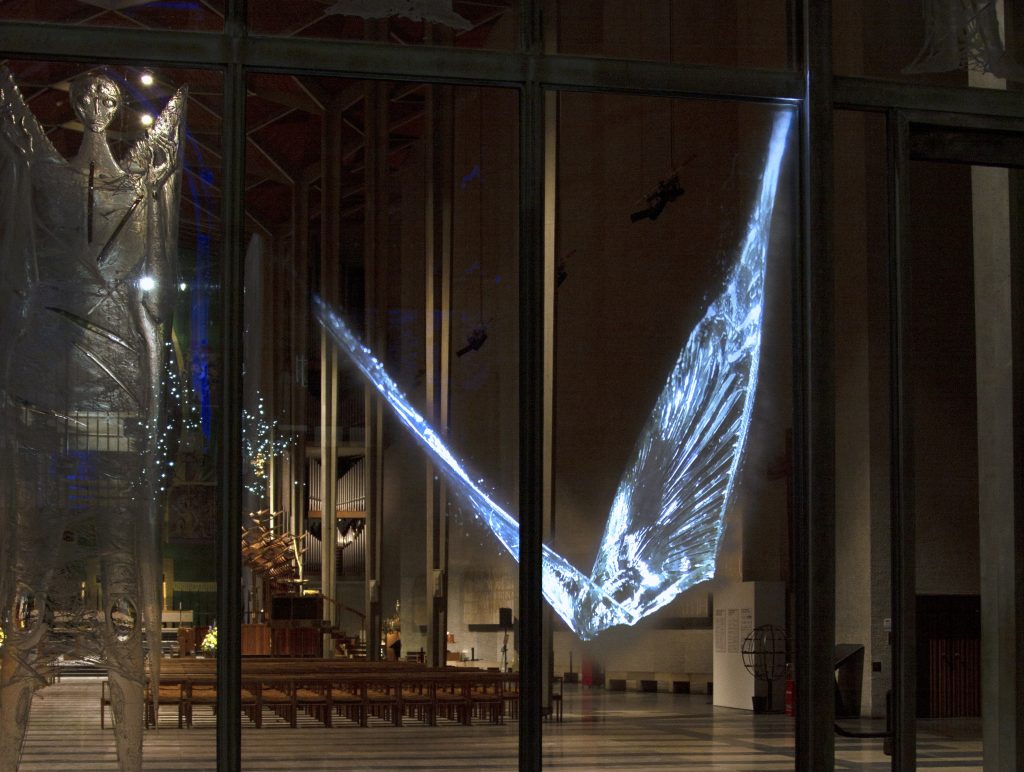 Lichtung-Break, Photograph, Anne Petters
Lichtung-Break, Photograph, Anne Petters
Discuss your perspective of working with this Cathedral.
Working with the team of Coventry Cathedral from Dean John Witcombe and curator Mike Tooby to all the committed staff has been a heart warming and inspiring experience. The openness, deep conversations and support I received helped me immensely to develop the installation without restrictions or problems.
Dresden is the twin city of Coventry, which gave the project another personal level, although the invitation to work on this project had nothing to do with that. We realised this connection later. It was one of the wonderful serendipities that happened along the journey.
Coventry Cathedral is a most welcoming place that brings people together, regardless of their backgrounds and beliefs. It seems to be the heart of Coventry.
Discuss your involvement with the Bullseye Projects?
Bullseye Projects is run by the Bullseye Glass Company, based in Portland Oregon, US. They represent me regularly at the London Art Fair COLLECT and in 2019 invited me to take part in a site specific exhibition in Caithness Scotland at their Byre Space, a converted old barn, typical for the area in Scotland. The exhibition titled ‘Field Notes’ included four acclaimed glass artists based in the UK. Bullseye is internationally known for their beautiful glass and their support for glass artist and glass education.
Comment on your work Lichtung – White Drift and Disegno.
How have you used writing on the glass?
Disegno, Lichtung – DRIFT and the series Books of Disquiet originate in my fascination for our never-ending flow of thoughts, the phenomenon of imagination itself and the desire to gain control over ephemeral moments. The rolling up, ripping off and freezing of unique thought moments, is realised in translucent glass sheets, frozen in movement. The drawings and the words on each glass object are records of those moments in time.
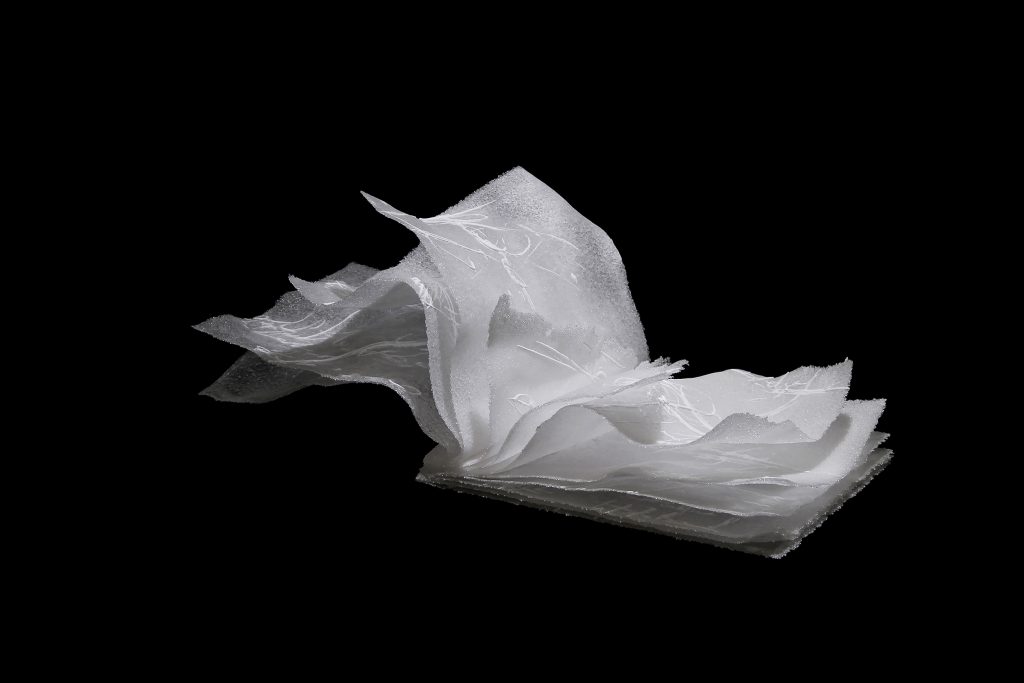
Books of Disquiet 2018, Photograph, Anne Petters
The pieces are made in a special pate-de-verre technique, which allows me an immediate and expressive way of bringing drawings onto glass. I see it as a form of intaglio printing translated into a kiln forming process. I use plaster-silicone moulds as printing plates on which I write reverse and then carve into the moulds tracing the spontaneous writings. White and clear glass frit is then sifted onto the mould and fused at about 720° Celcius to thin ice like sheets of glass. The pieces are then assembled to books or free forms and shaped in the kiln at 700°C. The process moves between control and randomness, which gives the pieces the natural, timeless and fleeting form. Process informs the concept in this case.
I see Lichtung – White Drift and the Books of disquiet as physical manifestations of the intangible phenomenon of imagination, one interpretation of this liquid space, as an attempt to freeze moments of thought. They reflect on the desire to control randomness and fleetingness.
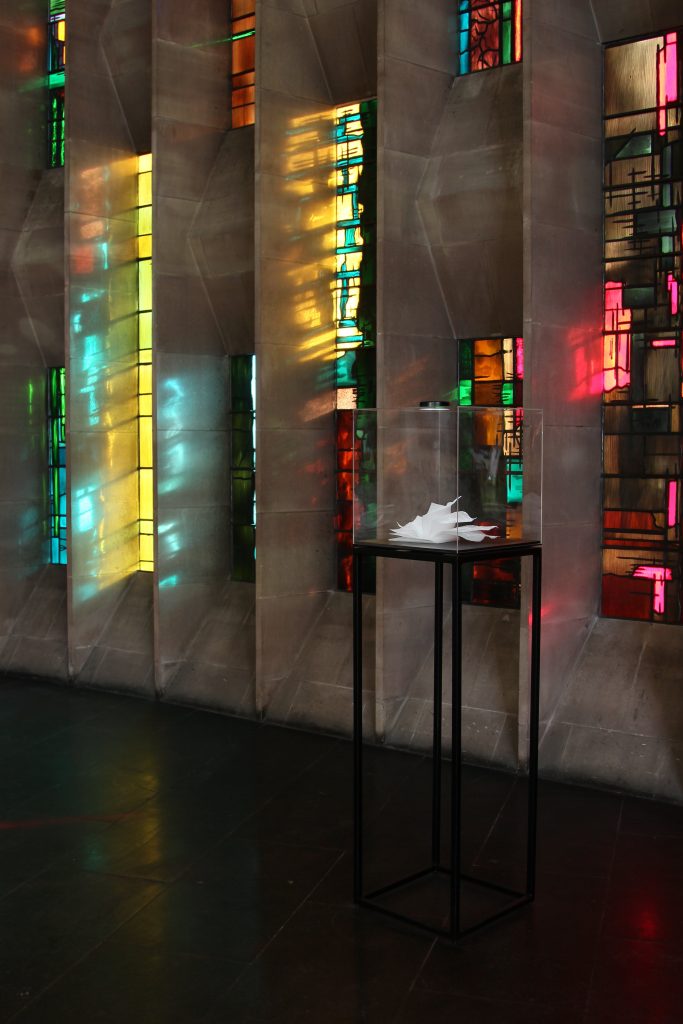 Lichtung White Drift, Photograph, Anne Petters
Lichtung White Drift, Photograph, Anne Petters
The writings are personal poems and thought fragments that run through my mind at the very moment of recording them.
The marks seem to contain information and draw the viewer into a secret but at the same time they elude themselves back into the ephemeral space they came from.
The handwritten text and drawings on these pieces are very subtle and cryptic. Therefore, although they are very personal, they function more as a visual comment on imagination itself rather than as a source of information.
The book as an object is a universal symbol for eternalizing one’s ideas. It contains and frames a certain space of someones mind. Once printed ideas are manifested, materialised and frozen in time.
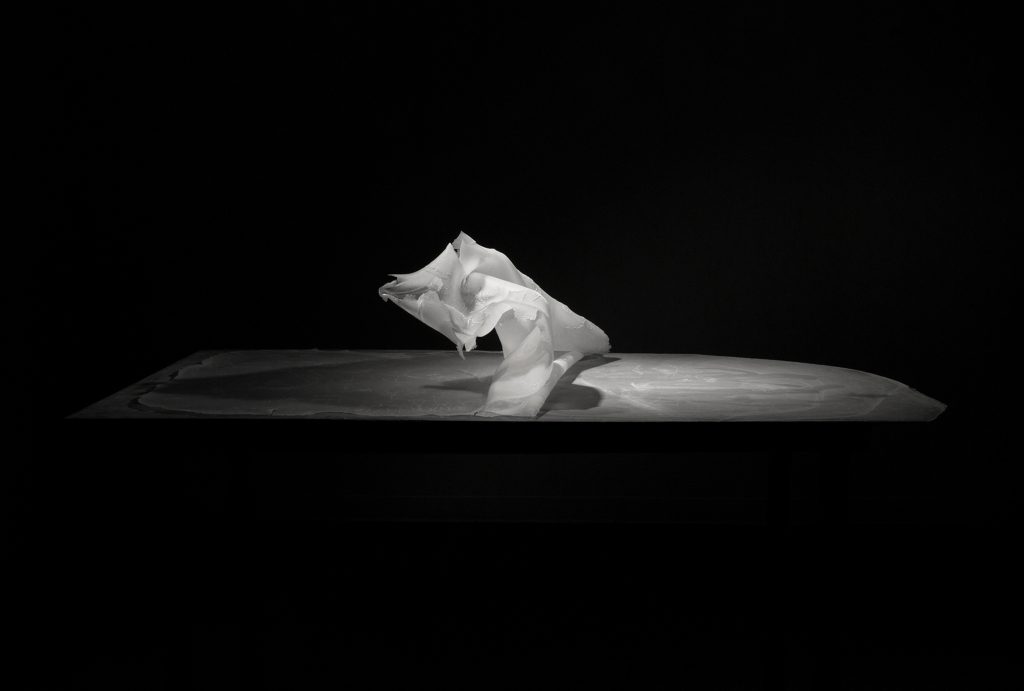
Disegno II, 2011 pate de verre hotprint glass, plaster, wood, 110cmx132cmx71cm, Photograph, Anne Petters
I am taking this object out of its function as a source of information and turn, it into a poetic image that pictures our innate desire to control time and fleetingness. The importance of making glass appear so fragile.
Discuss your comment, “…freezing moments of beauty” in relations to your glass art.
I am using certain properties of materials that pushes them to an aesthetic quality that trigger attraction and in the case of my glass work it is the fragility and ephemeral translucency that make these pieces so attractive and captivating. I believe that materials have a certain gravity on an emotional level and I like to use that to trigger curiosity and a sense of unearthliness. In the end all my work has the purpose of creating an intense sensation in the viewer, a moment of surprise, awe and wonder.
The natural, moving and beautiful forms of the books and the fragility of the pages suggest something so fragile that it seems they would blow away every moment, or melt. But they don’t. It is the essence, the image of timelessness for me.
Weises-Rauschen-2020
Tell us about your time at Pilchuck Glass School.
The Pilchuck Glass School is an important place for the glass community. Established in the 70’s by Dale Chihuly and friends, it was an experimental pioneering glass studio in the forest of the Pacific North West, two hours h north of Seattle. Glass as an art form was very young and niche at the time. The school developed into one of the most vibrant and important places for artists interested in glass. For everyone who has ever spend time there it has been a life changing experience one way or the other. I first worked at the Pilchuck Glass School in 2014 as one of six emerging artist in residents. The seven week long residency allowed me to experiment and play through some ideas, which now almost 10 years later have come to life in my work Sombre, large black glass leaves referencing the shadows of things.
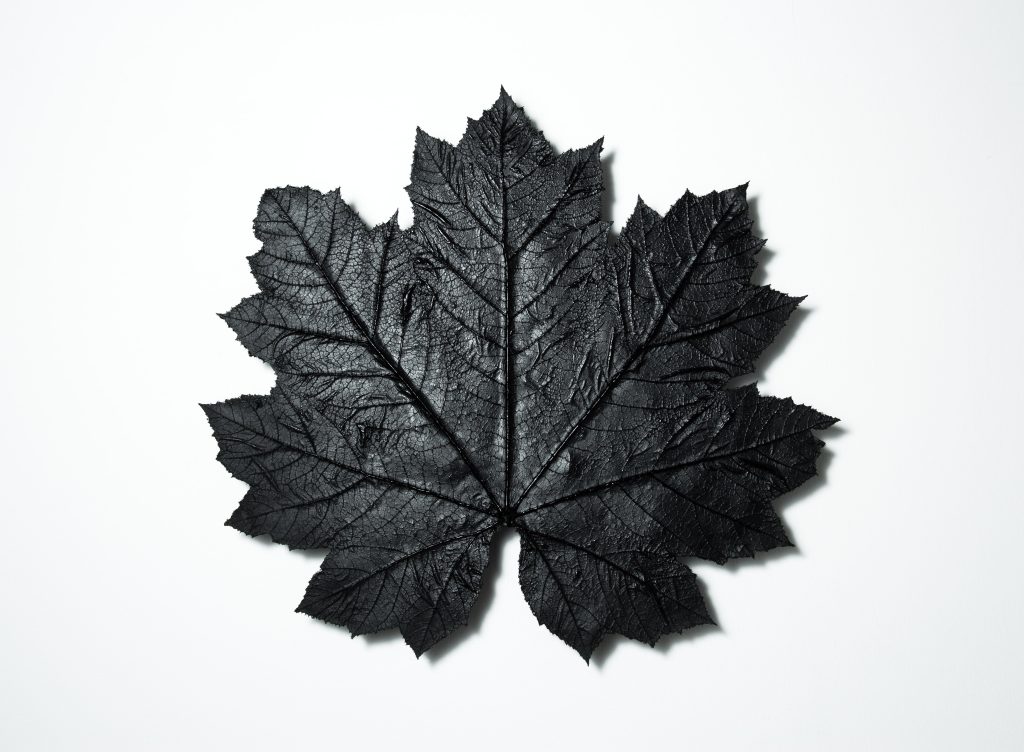 Sombre (n3), 2022, 56x50x2cm
Sombre (n3), 2022, 56x50x2cm
The school is located in a magical isolated mountainous region. Spending such a long time in nature has informed my work immensely, and helped continue conceptual ideas of my installation work like BeautyII, One and 1ALL from 2011, which all use natural phenomena as theme of desire to freeze beautiful moments in time.
 Umbra, black glass, 2023, 52cm x 49cm x 19cm
Umbra, black glass, 2023, 52cm x 49cm x 19cm
Discuss the importance of residencies and membership of many important glass organizations.
Working with glass as a professional artist is very challenging. My practice requires certain equipment and a lot of space. To survive as a glass artist who does not come from a wealthy background is a daily challenge. Establishing a private glass studio is for many of us a dream that takes many many years of commitment and sacrifice on one’s personal life. Residencies offer fantastic opportunities for artists to spend a focused time on developing new work without interruption of daily life. Especially as emerging artists working with this challenging material you need time and support to build up skills and a body of work. I always experienced the glass community as a supportive network, where artists share their research and help each other. Being on the board of the Summer Academy Bild-Werk for instance for almost 10 years has both provided me with a constantly growing network of inspiring and committed artists and also allows me to give other artists and my students the opportunity to meet and widen their network.
 Silent Echo Byre 2019
Silent Echo Byre 2019
Anne Petters
petters.anne@gmail.com
Anne Petters, London, England
Interview by Deborah Blakeley, January, 2024
Images on this page are all rights reserved by Anne Petters
Think a colleague or friend could benefit from this interview?
Knowledge is one of the biggest assets in any business. So why not forward this on to your friends and colleagues so they too can start taking advantage of the insightful information the artist has given?
Other artists you may be interested in:


